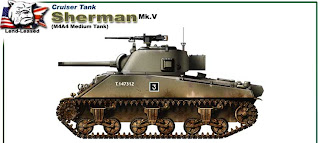WW2 Drawings
Another fine link provided by Ron. This is an example of the quality of these detailed drawings:

A Sherman MV of the 2nd Armoured Irish Guards, Guards Armoured Division, Normandy, July 1944, a side view from from this page.

A Sherman MV of the 2nd Armoured Irish Guards, Guards Armoured Division, Normandy, July 1944, a side view from from this page.

6 Comments:
Hi guys thanks for tis link it is brilliant. I also had a look at the propaganda christmas cards also
great and the home site for it is amazing."psywarrior.com"
These drawings are truly remarkable and so fine a detail
as I have ever seen - only one little nitpick the Churchill MK1v in Tunisisa did not sling anything on the sides of the turrets -a wire cage was welded to the back pannier, for bedding etc which had the nasty habit of attracting M/c gun bullets
and so we occasionaly had air conditioned blankets !
Interestingly on scrolling down through the Infantry tanks to note the drawing of the Churchill " Black Prince" - a wider - 50 ton version armed with the 17 pounder - we could have used those in Italy all the time - but not to be as it never made it and they went for both the Cromwell and the Comet albeit later on came the Challenger series as well as Chieftains - Conquerers et al until we appear to have gone back to the Challenger - up rated with the 120 MM gun - that would be a shock tearing throught your turret - IF the turret was still attached to the hull!
Tom
The 'Black Prince' was a good idea too late. It never went into production. It was all part of the attempt to get the superb 17pdr gun onto a cruiser tank. Vauxhall were asked to go ahead with a version of the Churchill for the 17pdr in September 1943, the main drawback being the narrowness of the Churchill's hull.
Designated the A3, it was initially known as a Super Churchill, but was later officially named Black Prince.
Whilst it utilised Churchill VII components as much as possible, it needed much redesign work because of the wider hull required. But it used the same Bedford twin-six engine and this, combined with the increased weight to 50 long tons, with wider 24" tracks, reduced its top speed to just 11 mph.
As for other changes, the air intakes were mounted on the hull top instead of at the side, with the engine exhaust at the hull rear.
Six prototypes were ordered and these were delivered for trials in May 1945, days after the war ended in Europe. They were given a full trial, but no production order was placed because the A41 Centurion was ready at the same time and proved much superior.
Info from Peter Chamberlain and Chris Ellis' excellent British and American Tanks of World War Two
Very interesting: I have some photographs of WW2 tanks taken at various locations in Normandy and the Neherlands. I will post copies of one or two of them as they may be of interest.
I only really have a basic knowledge about the various army tanks. Possibly those of you who have more technical knowledge about tanks will have a better idea of them.
Peter -
very interesting story as I was led to believe the main reason for not having 17 pounders mounted was that the turret ring was too small- so widening the main hull would have solved that problem - the 11 mph might not have been too much of an issue as we were down to walking paces to keep the infantry around us - the air intakes at the rear sounds good as they were the aiming point - less than two inches of steel covering the main petrol tanks leading to the engine
especially with our Tank names all over them !
Post a Comment
<< Home